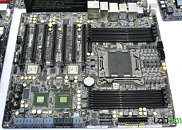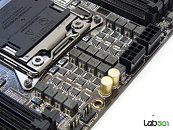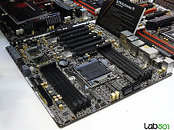Monday, March 5th 2012

ASRock Unveils Jaw-Dropping X79 Extreme11 Motherboard
A serious player in the PC motherboard industry, the world's 3rd biggest (in terms of volumes) at that, ASRock is one brand that has accumulated the engineering potential to make anything. It's far from finished with its LGA2011 motherboard lineup, and made sure visitors at its CeBIT booth had their jaws on the floor. Enter, the ASRock X79 Extreme11. This motherboard is designed for not just extremely-overclocked PCs, but battlestations holding their own huge storage arrays. This monster is built in the EATX form-factor.
The LGA2011 socket is powered by a 16+2 phase DigiPower VRM, which draws power from two 8-pin EPS connectors. It is wired to eight DDR3 DIMM slots, supporting up to 64 GB of quad-channel DDR3 memory with speeds of over DDR3-2400 MHz by overclocking. The memory areas are powered by 4+4 phase VRM. Apart from the 24-pin ATX connector, and the two EPS connectors, the board also draws power from two 4-pin Molex connectors. The board makes use of Japanese-made solid-state capacitors almost throughout.How the ASRock X79 Extreme11 marshals the 32 PCI-Express 3.0 lanes from the LGA2011 CPU is particularly interesting. Each of the two PCI-Express 3.0 x16 links from the CPU appear to pass to a bridge chip (PLX PEX8747), which takes in a Gen 3.0 x16 link to give out two Gen 3.0 x16 links. The four PCI-Express 3.0 x16 links thus generated, are distributed among the seven PCI-Express x16 long slots, and go on to drive other onboard devices. NVIDIA 4-way SLI and AMD 4-way CrossFireX are naturally supported.
Speaking of onboard devices, south of the X79 PCH, you will notice a big LSI-branded chip. That's the LSI SAS2308 storage processor, which gives out eight SAS/SATA 6 Gb/s ports, complete with support for several complex RAID modes. What makes this chip bleeding-edge is its support for PCI-Express 3.0. All eight SAS ports from the SAS2308 are wired out as internal ports, next to two SATA 6 Gb/s and four SATA 3 Gb/s ports from the Intel X79 PCH.
Moving on, the sound subsystem on the X79 Extreme11 is care of Creative Sound Core3D audio processor, with 8 channels output, and support for THX TruStudio Pro. There are two gigabit Ethernet interfaces, driven by Broadcom-made controllers. There are a total of eight USB 3.0 ports (four on the rear-panel, four via headers). A variety of ASRock-exclusive features are found, including UEFI BIOS with System Browser, XFastLAN, XFastUSB. The heatsinks have not taken shape, but the one over the PCH is sure to feature a fan.
Source:
Lab501.ro
The LGA2011 socket is powered by a 16+2 phase DigiPower VRM, which draws power from two 8-pin EPS connectors. It is wired to eight DDR3 DIMM slots, supporting up to 64 GB of quad-channel DDR3 memory with speeds of over DDR3-2400 MHz by overclocking. The memory areas are powered by 4+4 phase VRM. Apart from the 24-pin ATX connector, and the two EPS connectors, the board also draws power from two 4-pin Molex connectors. The board makes use of Japanese-made solid-state capacitors almost throughout.How the ASRock X79 Extreme11 marshals the 32 PCI-Express 3.0 lanes from the LGA2011 CPU is particularly interesting. Each of the two PCI-Express 3.0 x16 links from the CPU appear to pass to a bridge chip (PLX PEX8747), which takes in a Gen 3.0 x16 link to give out two Gen 3.0 x16 links. The four PCI-Express 3.0 x16 links thus generated, are distributed among the seven PCI-Express x16 long slots, and go on to drive other onboard devices. NVIDIA 4-way SLI and AMD 4-way CrossFireX are naturally supported.
Speaking of onboard devices, south of the X79 PCH, you will notice a big LSI-branded chip. That's the LSI SAS2308 storage processor, which gives out eight SAS/SATA 6 Gb/s ports, complete with support for several complex RAID modes. What makes this chip bleeding-edge is its support for PCI-Express 3.0. All eight SAS ports from the SAS2308 are wired out as internal ports, next to two SATA 6 Gb/s and four SATA 3 Gb/s ports from the Intel X79 PCH.
Moving on, the sound subsystem on the X79 Extreme11 is care of Creative Sound Core3D audio processor, with 8 channels output, and support for THX TruStudio Pro. There are two gigabit Ethernet interfaces, driven by Broadcom-made controllers. There are a total of eight USB 3.0 ports (four on the rear-panel, four via headers). A variety of ASRock-exclusive features are found, including UEFI BIOS with System Browser, XFastLAN, XFastUSB. The heatsinks have not taken shape, but the one over the PCH is sure to feature a fan.



22 Comments on ASRock Unveils Jaw-Dropping X79 Extreme11 Motherboard
Youtube Y u no let me embed?
Work's for me :o Try to wrap [ yt ] [ /yt ] (minus the space's) around UePtoxDhJSw and you should be golden :)
Wonder who else is bringing out X79 boards for Cebit... I will be waiting tell later next week to start ordering for my X79 build :cool:Why do people keep saying this.... not something they can do or change.
Intel has complete control over it and Intel tends to do what they want... Xeons belong on dual socket boards.
In other words Intel has to change the chipset, the motherboard companies don't make the chipsets Intel does.
Maybe if Intel would release 3930K/3960X with dual QPI.... Atleast the 3960X should have it... only 3 MB of L3 cache difference with the little brother can't justify the price on top but with dual QPI it would be awesome AND a price tag justifier
EDIT: 1000 posts o.O
The LSI SAS2308 is a good inclusion (not a bad chip compared to the SAS2008 btw :cool: ), though IMO the exclusion of mini SAS connections is a bad move (With the $ these boards will be asking a few mini SAS to SATA cables would not break the budget, could even throw one in with the board to avoid those buying the wrong type of cable :shadedshu ).
For a direct comparison you could see this chip featured on the LSI SAS9205-8e (LSI SAS2308) compared to the older 2nd gen chip on the LSI SAS9200-8e (LSI SAS2008) for those who may be running the earlier model chip on some SAS HBA/RAID cards (namely the 9211-8i as it's cheaper equivalents use the same chip, great combo with a HP/Intel or even Chenbro SAS Expanders).
www.lsi.com/products/storagecomponents/Pages/LSISAS9205-8e.aspx
www.lsi.com/channel/products/storagecomponents/Pages/LSISAS9200-8e.aspx
lime-technology.com/forum/index.php?topic=12767.0
I hope those links help to demonstrate just how hamstrung that LSI chip really is on this motherboard.
As for the PCIe lanes; I have no idea how those port multipliers will affect other cards (SAS, Network cards, etc) but in a build loaded GPUs and careful OC of the appropriate CPU it could pull some serious performance in games, folding, 3D Rendering/video encoding/CAD and other things (just maybe 60/120 FPS real time ray tracing :twitch: )